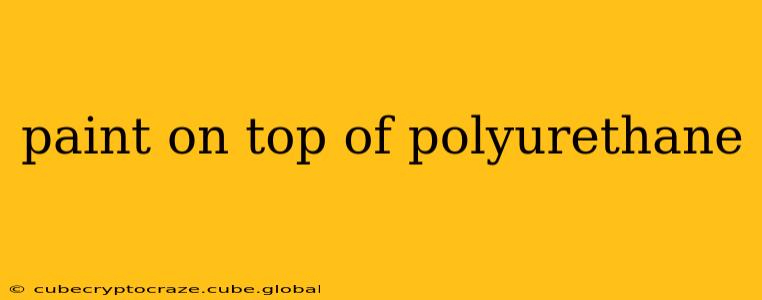Polyurethane is a durable, long-lasting finish popular for furniture, floors, and other surfaces. However, situations arise where you need to paint over it. Whether it's a change of décor or a necessary repair, painting over polyurethane requires careful preparation to ensure a successful and long-lasting finish. This guide will walk you through the entire process, answering common questions and offering expert advice.
Can You Paint Over Polyurethane?
Yes, you can paint over polyurethane, but it's not as simple as applying paint directly. Polyurethane's smooth, non-porous surface creates a barrier that prevents paint from adhering properly. Without proper preparation, the paint will likely peel, chip, or crack. The key is to create a surface that the paint can grip onto.
How to Prepare a Polyurethane Surface for Painting
This is the most crucial step. Failing to properly prep the surface will doom your project. Here's a step-by-step guide:
1. Cleaning the Polyurethane Surface
Begin by thoroughly cleaning the surface to remove dirt, grease, and dust. Use a degreaser or TSP (trisodium phosphate) solution, following the product instructions carefully. Rinse thoroughly with clean water and allow the surface to dry completely. This ensures the best possible adhesion for the primer.
2. Lightly Sanding the Polyurethane
Once dry, lightly sand the polyurethane surface with fine-grit sandpaper (220-grit or higher). This creates a slightly rough texture that helps the primer bond effectively. Focus on achieving a matte finish; you don't need to sand aggressively. Remember to remove all sanding dust with a tack cloth or a slightly damp cloth before proceeding.
3. Applying a Bonding Primer
This step is essential. A bonding primer is designed to adhere to slick surfaces like polyurethane. It bridges the gap between the existing finish and the topcoat of paint, ensuring a strong and durable bond. Apply the primer evenly in thin coats according to the manufacturer's instructions. Allow each coat to dry completely before applying the next. Multiple thin coats are better than one thick coat.
What Kind of Paint Should I Use Over Polyurethane?
The type of paint you choose depends on the surface and your desired finish. Oil-based paints generally offer better adhesion to polyurethane than water-based paints, but water-based paints are lower in VOCs and easier to clean up. Consider using a high-quality, acrylic-alkyd hybrid paint for a good balance of durability, adhesion, and ease of use.
What is the Best Primer for Painting Over Polyurethane?
A high-quality bonding primer specifically designed for use over slick surfaces is crucial. Look for primers that are labeled as suitable for use over glossy surfaces or polyurethane. Read reviews and choose a product with a proven track record of success.
Should I Use a Deglosser Before Painting Over Polyurethane?
While sanding usually provides sufficient surface roughness, a deglosser can further help to improve adhesion, especially on very glossy surfaces. Apply a deglosser according to the manufacturer's instructions, and ensure the surface is thoroughly clean and dry before applying the primer.
How Many Coats of Paint Should I Apply?
Typically, two coats of paint are sufficient, but you may need more depending on the desired coverage and the color of the paint. Always allow each coat to dry completely before applying the next. Follow the paint manufacturer's instructions for drying times.
This comprehensive guide offers a detailed approach to successfully painting over polyurethane. Remember, proper preparation is key. Taking the time to clean, sand, and prime the surface will greatly increase your chances of achieving a beautiful and long-lasting painted finish.
